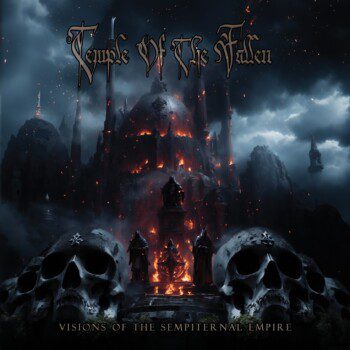
Temple of the Fallen is a Symphonic/Melodic Death Metal solo artist (“Melkor”) from Portugal. On August 5th, 2015, Melkor released his first/debut solo full-length album, “Visions Of The Sempiternal Empire”. Which was released and remastered on 13th September 2024, and released through Supergoat Wreck-Whordes / Studios13.
Temple of the Fallen Social Links
Temple of the Fallen, Visions of the Sempiternal Empire Review: This review will evaluate every aspect of the album, from its intricate musical composition to its production. Our analysis will provide valuable insights to help you determine if this album is worth adding to your collection.
The First Three Sins of Visions of the Sempiternal Empire
Let’s start by discussing the first three sins of Temple of the Fallen and his album, Visions of the Sempiternal Empire
The First Sin, The Strings/Keys: Showcases a dynamic interplay of rhythmic and melodic intensity, dancing between aggressive power and delicate complexity. The foreboding symphonic interludes create a chilling atmosphere backdrop that enhances the overall experience. The Second Sin, The Vocals: Melkor‘s vocal performances are nothing short of raw and electrifying. The Third Sin—The Percussions: Delves into a vast world of a rich landscape of vibrant beats and complex fills, driving the music with relentless energy and momentum.

The Fourth Sin: Overall Discussion:
The interplay of symphonic grandeur and the intensity of melodic death metal elements…
Before we get to the article, let’s talk about who Temple of the Fallen is. Temple of the Fallen is founded by Melkor, a single artist who has a few other projects and a few bands to name. Now, this is where the excitement begins for Athenaeum of Sin, and looking forward to it. When Melkor approached us for a review, we enchanted a six-album submission from Melkor. So it’s fitting to start off with his first solo album, Temple of the Fallen, and work through the rest of the reviews and his work.
Let’s continue with the review of the Temple of the Fallen. The opening piece, Visions of the Sempiternal Empire, welcomes the listener with an underground but melodic and aggressive vocal introduction…
As the listener continues their journey with the second piece, The Blade and its Splendor, and the remaining seven pieces, taken inspiration (from what I can gather) from the author Clark Ashton Smith (1893-1961) and providing a captivating tapestry of sound. Weaving together a raw and underground essence with an aggressive, yet symphonic melodic range across nine compositions that span a total of forty minutes. Among these, the third piece, …of Magic and Wind, stands out as a poignant instrumental tribute to Melkor‘s late friend, Jorge Silva (1976-2015). This composition is enriched by the gentle patter of rain and piano intro, which envelops the listener in a haunting sense of melancholy, melodic and sorrowful atmosphere, elevating the emotional depth of the piece.
As the listener continues their excursion through the remaining six tracks, inviting the listener to indulge in this alluringly dark forbidden fruit of art. Each piece pulsates with rhythmic intensity, showcasing a fruit of art guitar work that dances between ferocity and finesse. The ominous symphonic interludes serve as a haunting backdrop, that captivates the senses and elevates the listening experience to new heights. The energetic drum beats and intricate fills propel the music forward, creating an exhilarating auditory experience that captivates the senses. Melkor‘s vocal performances are nothing short of electrifying, delivering a visceral intensity that resonates deeply with the listener. Melkor’s aggressive vocal style complements the intricate instrumentation, forging a powerful connection that leaves an indelible mark.
As the listener delves deeper into the album, the listener is greeted with a diverse array of tempos, moods, and atmospheres, each composition unfolding like a grand narrative. The epic nature of the recordings is evident, with every piece executed to perfection, ensuring that the listener is enveloped in a soundscape that is both grandiose and intimate. Every droplet of composition and musical scoring is captured in a production that is well executed with perfection, even shining through and capturing the music, like a story in a book.
Visions of the Sempiternal Empire is a well-constructed composition that shows within the instrumental composition/arrangement, musical score, and devilmanship. Each arrangement is distinct, weaving a rich tapestry of sound that oscillates between moments of profound darkness and triumphant uplift. This dynamic interplay creates an immersive experience, where the shadows are ultimately vanquished by an invigorating atmosphere, only to be momentarily eclipsed again, inviting the listener to traverse a landscape of emotional depth and complexity.
I would like to draw your attention to the eighth track, A Chalice of Sulphur, which features the esteemed guest artist Christian P. Weller of Amidst Dreams of Tomorrow. His contributions of strings and choral vocals add a rich layer of texture to the composition, enhancing its already profound emotional resonance. This collaboration not only highlights the synergy between the artists but also elevates the overall narrative of the album, inviting listeners to immerse themselves in its haunting beauty and intricate devilmanship.
Visions of the Sempiternal Empire is a collection of nine compositions that invite the listener to explore the depths of emotion and imagination. Simultaneously inviting the listener to lose themselves in the enchanting world, known as Temple of the Fallen.
From the very first note to the last chord, I was completely engrossed in the entire forty-minute journey. A level of production that felt polished and expertly crafted was showcased by the strength of the instrumental arrangement, vocal performances, and overall musical scoring and devilmanship.
The album concludes with the final track, Return of the Templars. Greeting the listener with an acoustic introduction, subsequently evolving into a composition characterized by a melodic and folk-like composition. Return of the Templars effectively wraps up the album, particularly highlighted by the flutes in the closing moments. We want to give a shoutout to Melkor for letting us review his Visions of the Sempiternal Empire album. Now, we are going to conclude the review by talking about the final three sins and concluding the review.
The Last Three Sins
Let’s discuss the last three sins of Temple of the Fallen and his album, Visions of the Sempiternal Empire
The Fifth Sin, The Memorabilia:
Visions of the Sempiternal Empire presents a unique auditory experience, seamlessly blending a captivating interplay of symphonic grandeur and the intensity of melodic death metal elements that resonate throughout its compositions. This intricate fusion creates an atmosphere rich with complexity. The presence of melancholy moments within the tracks not only enhances the emotional resonance but also adds a remarkable depth, transforming each listening experience into a journey of exploration and introspection.
We are excited to dive deeper into Melkor‘s musical domain and share our insights as we begin this first review of six, and looking forward to expressing our thoughts on his work.
The Sixth Sin, The Artwork:
I am fond of the Visions of the Sempiternal Empire artwork, as it embodies not only the musical feel but also the Clark Ashton Smith and Lovecraftian universe.
The Seventh Sin, Disrelish:
Nothing to disrelish within the musical spectrum of Temple Of The Fallen and his album, Visions Of The Sempiternal Empire. Therefore, this concludes Temple Of The Fallen and his album, Visions Of The Sempiternal Empire review.
Members
Melkor: guitars, drums
Christian P. Weller: guest guitar & vocals on track 8
Track-Listing
01. Visions of the Sempiternal Empire
02. The Blade and its Splendor
03. …of Magic and Wind (instrumental)
04. The Headless Giant
05. Ride Intro Infinity
06. Plateau of Cosmic Glory
07. The Dawn of Black Rain
08. A Chalice of Sulphur
09. Return of the Templars

